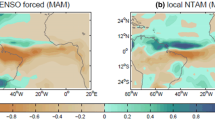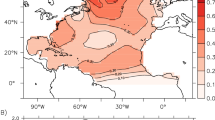Abstract
We examine the role of local and remote sea surface temperature (SST) on the tropical cyclone potential intensity in the North Atlantic using a suite of model simulations, while separating the impact of anthropogenic (external) forcing and the internal influence of Atlantic Multidecadal Variability. To enable the separation by SST region of influence we use an ensemble of global atmospheric climate model simulations forced with historical, 1856–2006 full global SSTs, and compare the results to two other simulations with historical SSTs confined to the tropical Atlantic and to the tropical Indian Ocean and Pacific. The effects of anthropogenic plus other external forcing and that of internal variability are separated by using a linear, “signal-to-noise” maximizing EOF analysis and by projecting the three model ensemble outputs onto the respective external forcing and internal variability time series. Consistent with previous results indicating a tampering influence of global tropical warming on the Atlantic hurricane potential intensity, our results show that non-local SST tends to reduce potential intensity associated with locally forced warming through changing the upper level atmospheric temperatures. Our results further indicate that the late twentieth Century increase in North Atlantic potential intensity, may not have been dominated by anthropogenic influence but rather by internal variability.











Similar content being viewed by others
References
Bister M, Emanuel KA (1998) Dissipative heating and hurricane intensity. Meteor Atmos Phys 65:223–240
Bister M, Emanuel KA (2002a) Low frequency variability of tropical cyclone potential intensity: 1. Interannual to interdecadal variability. J Geophys Res 107:4801. doi:10.1029/2001JD000776
Bister M, Emanuel KA (2002b) Low frequency variability of tropical cyclone potential intensity: 2. Climatology for 1982–1995. J Geophys Res 107:4621. doi:10.1029/2001JD000780
Bryan GH, Rotunno R (2009) The maximum intensity of tropical cyclones in axisymmetric numerical model simulations. Mon Weather Rev 137:1770–1789
DelSole T, Tippett MK, Shukla J (2011) A significant component of unforced multidecadal variability in the recent acceleration of global warming. J Clim 24:909–926
Emanuel KA (1986) An air-sea interaction theory for tropical cyclones. Part I: steady-state maintenance. J Atmos Sci 43:585–604
Emanuel KA (1987) The dependence of hurricane intensity on climate. Nature 326:483–485
Emanuel KA (1988) The maximum intensity of hurricanes. J Atmos Sci 45:1143–1155
Emanuel KA (1995) Sensitivity of tropical cyclones to surface exchange coefficients and a revised steady-state model incorporating eye dynamics. J Atmos Sci 52:3969–3976
Emanuel K (2005) Increasing destructiveness of tropical cyclones over the past 30 years. Nature 436:686–688
Emanuel K (2010) Tropical cyclone activity downscaled from NOAA-CIRES Reanalysis, 1908–1958. J Adv Model Earth Syst 2. doi:10.3894/JAMES.2010.2.1
Emanuel K, Solomon S, Folini D, Davis S, Cagnazzo C (2012) Influenced of tropical tropopause layer cooling on Atlantic hurricane activity. J Clim (submitted)
Enfield DB, Mestas-Nunez AM, Trimble PJ (2001) The Atlantic multidecadal oscillation and it’s relation to rainfall and river flows in the continental U.S. Geophys Res Lett 28:2077–2080
ERA-Interim (2011) ERA-Interim re-analysis brief description, http://www.ecmwf.int/research/era/do/get/ERA-Interim_brief
Goldenberg SB, Landsea CW, Mestas-Nuñez AM, Gray WM (2001) The recent increase in Atlantic hurricane activity: causes and implications. Science 293:474–479
Graumann A, Houston T, Lawrimore J, Levinson D, Lott N, McCown S, Stephens S, Wuertz D (2005) Hurricane Katrina—a climatological perspective. NOAA’s National Climatic Data Center, Technical Report 2005-01
Gray WM (1968) Global view of the origin of tropical disturbances and storms. Mon Weather Rev 96:669–700
Gray WM (1979) Hurricanes: their formation, structure and likely role in the tropical circulation. Meteorology over the tropical oceans. Royal Meteorological Society, Bracknall
Holland GJ (1997) The maximum potential intensity of tropical cyclones. J Atmos Sci 54:2519–2541
Kalnay E et al (1996) The NCEP/NCAR 40-year reanalysis project. Bull Am Meteorol Soc 77:437–471
Kaplan A, Cane MA, Kushnir Y, Clement AC, Blumenthal MB, Rajagopalan B (1998) Analyses of global sea surface temperature: 1856–1991. J Geophys Res 103:18567–18589
Kiehl JT, Hack JJ, Bonan GB, Bovile BA, Williamson DL, Rasch PJ (1998) The national center for atmospheric research community climate model: CCM3. J Clim 11:1131–1149
Kistler R et al (2001) The NCEP-NCAR 50-year reanalysis: monthly means CD-ROM and documentation. Bull Am Meteorol Soc 82:247–267
Kossin JP, Camargo SJ (2009) Hurricane track variability and secular potential intensity trends. Clim Chang 9:329–337
Kossin JP, Vimont DJ (2007) A more general framework for understanding Atlantic hurricane variability and trends. Bull Am Meteorol Soc 88:1767–1781
Kossin JP, Camargo SJ, Sitkowski M (2010) Climate modulation of North Atlantic hurricane tracks. J Clim 23:3057–3076
Kushnir Y (1994) Interdecadal variations in North Atlantic Sea surface temperature and associated atmospheric conditions. J Clim 7:141–157
Kushnir Y, Seager R, Ting M, Naik N, Nakamura J (2010) Mechanisms of tropical Atlantic SST influence on North American precipitation variability. J Clim 23:5610–5628
Lau N-G, Nath MJ (1994) A modeling study of the relative roles of tropical and extratropical SST anomalies in the variability of the global atmosphere-ocean system. J Clim 7:1184–1207
Mann ME, Emanuel KA (2006) Atlantic hurricane trends linked to climate change. EOS. Trans Am Geophys Union 87:233–241
Montgomery MT, Van Sang N, Smith RK, Persing J (2009) Do tropical cyclones intensify by WISHE? Q J R Meteorol Soc 135:1697–1714
Palmén EH (1948) On the formation and structure of tropical cyclones. Geophysica 3:26–38
Ramsay HA, Sobel AH (2011) Effects of relative and absolute sea surface temperature on tropical cyclone potential intensity using a single-column model. J Clim 24:183–193
Rayner N, Parker D, Horton E, Folland C, Alexander L, Rowell D, Kent E, Kaplan A (2003) Global analyses of sea surface temperature, sea ice, and night marine air temperature since the late nineteenth century. J Geophys Res 108:4407. doi:10.1029/2002JD002670
Schubert S et al (2009) A US CLIVAR project to assess and compare the responses of global climate models to drought-related SST forcing patterns: overview and results. J Clim 22:5251–5272
Seager R (2007) The turn of the century North American drought: global context, dynamics, and past analogs. J Clim 20:5527–5552
Seager R, Kushnir Y, Herweijer C, Naik N, Velez J (2005) Modeling of tropical forcing of persistent droughts and pluvials over western North America: 1856–2000. J Clim 18:4065–4088
Seager R, Kushnir Y, Ting M, Cane M, Naik N, Miller J (2008) Would advance knowledge of 1930s SSTs have allowed prediction of the dust bowl drought? J Clim 21:3261–3281
Servain J (1991) Simple climatic indexes for the tropical Atlantic-Ocean and some applications. J Geophys Res C 96:15137–15146
Smith RK, Montgomery MT, Vogl S (2008) A critique of Emanuel’s hurricane model and potential intensity theory. Quart J R Meteorol Soc 134:551–561
Sobel AH, Camargo SJ (2012) Projected future seasonal changes in tropical summer climate. J Clim 24:473–487
Sobel AH, Held IM, Bretherton CS (2002) The ENSO signal in tropical tropospheric temperature. J Clim 12:2702–2706
Solomon A, Goddard L, Kumar A, Carton J, Deser C, Fukumori I, Greene AM, Hegerl G, Kirtman B, Kushnir Y, Newman M, Smith D, Vimont D, Delworth T, Meehl GA, Stockdale T (2011) Distinguishing the roles of natural and anthropogenically forced decadal climate variability. Bull Am Meteorol Soc 92:141–156
Swanson KL (2008) Nonlocality of tropical cyclone intensities. Geochem Geophys Geosyst 9:Q04V01
Tang BH, Neelin JD (1994) ENSO influence on Atlantic hurricanes via tropospheric warming. Geophys Res Lett 31:L24204
Ting M, Kushnir Y, Seager R, Li C (2009) Forced and natural 20th Century SST trends in the North Atlantic. J Clim 22:1469–1481
Ting M, Kushnir Y, Seager R, Li C (2011) Robust features of Atlantic multidecadal variability and its climate impacts. Geophys Res Lett 38:L17705. doi:10.1029/2011GL048712
Uppala SM et al (2005) The ERA-40 re-analysis. Quart JR Meteorol Soc 131:2961–3012
Vecchi GA, Soden BJ (2007) Effect of remote sea surface temperature change on tropical cyclone potential intensity. Nature 450:1066–1070
Vecchi GA, Swanson KL, Soden BJ (2008) Whither hurricane activity? Science 322:687–689
Vecchi GA, Fueglistaler S, Held IM, Knutson TR, Zhao M (2012) Influence of tropical tropopause layer cooling on Atlantic hurricane activity. J Clim (submitted)
Villarini G, Vecchi GA (2012) Twenty-first-century projections of North Atlantic tropical storms from CMIP5 models. Nat Clim Chang Early online. doi:10.1938/nclimate1530
Vimont DJ, Kossin JP (2007) The Atlantic meridional mode and hurricane activity. Geophys Res Lett 34:L07709
Wing AA, Sobel AH, Camargo SJ (2007) The relationship between the potential and actual intensities of tropical cyclones on interannual time scales. Geophys Res Lett 34:L08810
Zhang R, Delworth TL (2006) Impact of Atlantic multidecadal oscillation on India/Sahel rainfall and Atlantic hurricanes. Geophys Res Lett 33:L17712
Acknowledgments
The authors acknowledge support of the National Oceanic and Atmospheric Administration (NOAA) Grants NA08OAR4320912, NA10OAR4310124 and NA10OAR4320137. We would like to thank Donna Lee and Naomi Naik (LDEO) for performing the CCM3 simulations used in this study. The authors would like to thank the Global Decadal Hydroclimate group at Lamont and Columbia for helpful discussion and input and two anonymous reviewers for their useful suggestions and comments.
Author information
Authors and Affiliations
Corresponding author
Rights and permissions
About this article
Cite this article
Camargo, S.J., Ting, M. & Kushnir, Y. Influence of local and remote SST on North Atlantic tropical cyclone potential intensity. Clim Dyn 40, 1515–1529 (2013). https://doi.org/10.1007/s00382-012-1536-4
Received:
Accepted:
Published:
Issue Date:
DOI: https://doi.org/10.1007/s00382-012-1536-4




